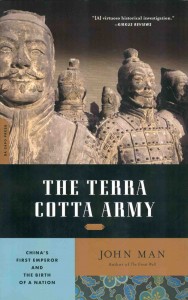 The discovery in 1974 of some 7,000 Chinese terra cotta warriors and horses from the First Emperor’s reign circa 200 BCE is one of the outstanding archaeological finds on th twentieth century. Several of these statutes have been on tour of U.S. museums, most recently at San Francisco’s Asian Art Museum.
The discovery in 1974 of some 7,000 Chinese terra cotta warriors and horses from the First Emperor’s reign circa 200 BCE is one of the outstanding archaeological finds on th twentieth century. Several of these statutes have been on tour of U.S. museums, most recently at San Francisco’s Asian Art Museum.
John Man’s landmark book, ‘The Terra Cotta Army: China’s First Emperor and the birth of a Nation (2008, ISBN 978-0-306-81744-1) is a comprehensive 288 page book containing 32 pages of photographs that encompasses the excitement of the find as well as the historical information needed to put it in perspective.
Man is an exceptional writer with a keen sense of curiosity and a writing style that unfolds the story magnificently. There’s much drama herein, from the machinations of historical Chinese warring factions to the politics surrounding the discovery of the statues and the involvement of the Chinese government. He has a wonderful chapter on the subject of the restoration process as well, as it’s a significant element in the story. By the end of the book, we’ll bet that most readers will seriously consider buying an airline ticket to see the statures in situ. As an example of Man’s considerable writing talents, consider his take on heavy-metal poisoning:
The taking of elixirs was a dangerous business, justified only by the supposed rewards. To experiment not only with gold and mercury – the favourites – but also with arsenic, lead, copper and tin was to poison oneself. Here, too, experience was no match for optimism. To quote a sixth-century text that ticks off an array of metal-poisoning symptoms:
After taking an elixir, if your face and body itch as though insects were crawling over them, if your hands and feet swell dropsically, if you cannot stand the smell of food and bring it up after you have eaten it, if you feel as though you were going to be sick most of the time, if you experience weakness in your four limbs, if you have to go often to the latrine, or if your head or stomach violently ache – do not be alarmed or disturbed. All these effects are merely proofs that the elixir you are taking is successfully dispelling your latent disorders.
 The theory behind these practices, wildly eccentric though they sound to outsiders (and sounded back then Confucians), was mainstream among Daoists for centuries. The elixirs were supposed to somehow rarefy or aetherialize the body (an idea that may have derived from the trance-inducing ‘magic mushroom’ potions taken by Siberian shamans and ancient Indian mystics), the purpose being generate a new self that was immortal though still physical. Adepts took elixirs during life to prevent decay after death. Indeed, arsenic has precisely this effect, presumably because it poisons not only the victim but also the bacteria that cause decay. Death thus becomes a doorway to immortality. The corpse of the successful adept would remain incorruptible and emerge like a butterfly from a chrysalis to dwell with immortals.
The theory behind these practices, wildly eccentric though they sound to outsiders (and sounded back then Confucians), was mainstream among Daoists for centuries. The elixirs were supposed to somehow rarefy or aetherialize the body (an idea that may have derived from the trance-inducing ‘magic mushroom’ potions taken by Siberian shamans and ancient Indian mystics), the purpose being generate a new self that was immortal though still physical. Adepts took elixirs during life to prevent decay after death. Indeed, arsenic has precisely this effect, presumably because it poisons not only the victim but also the bacteria that cause decay. Death thus becomes a doorway to immortality. The corpse of the successful adept would remain incorruptible and emerge like a butterfly from a chrysalis to dwell with immortals.
This book is a must-read for Chinese history enthusiasts as well as those interested in this most fascinating archaeological discovery. Buy it here at the WoWasis eStore.
Leave a Reply